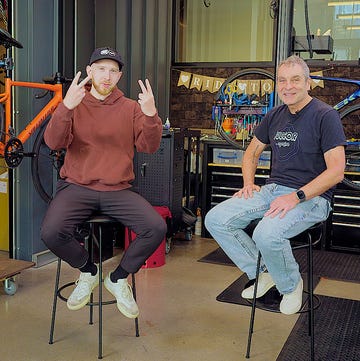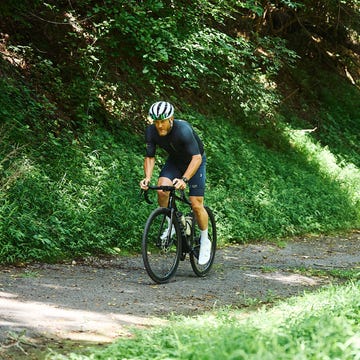Tim Rutledge, the creator of the Redline Conquest and a legend of American cyclocross racing, died of cancer earlier this year. Reading news of his passing made me recall the early days of my career in bicycle product development and reflect on today’s bikes.
Redline’s Conquest was groundbreaking. Released in 1994, it was the first widely available cyclocross bike in the United States. With the Conquest, racers didn’t need to chase down a cyclocross-specific frame from Europe or modify a road or touring bike to fit wider tires and cantilever brakes. Redline’s bike fueled a cyclocross boom and got thousands of racers into the sport. Within a few years, cyclocross became “the next big thing,” and every major bike brand began manufacturing ’cross bikes and marketing them with sponsored athletes. Most of these cyclocross bikes never got raced between the tape, but many were ridden on gravel and farm roads. And this helped gravel emerge as a bike category and cycling discipline.
While I designed bikes for downhill mountain biking (bicycles at the opposite end of the cycling use-case spectrum from cyclocross), I often studied and referenced the Conquest when developing and marketing bikes like the Iron Horse Sunday. Rutledge and Redline distilled a unique, discipline-specific bike into a product and price that more riders could access—and then backed it up by racing and winning on the product.
Almost every bicycle brand claims its shiny new bike is groundbreaking. But most are not. While we’ve seen some solid bikes come around in the past few years, the developments are more iterative than innovative. First, product development was stifled by pandemic sourcing challenges. And now, historically high inventory levels are to blame. Brands are teasing out grams of weight or aerodynamic drag, loading bikes with electronics, or chasing small benefits on new bikes. And all of it seems to cost more money every model year.
However, every few years, a truly groundbreaking bike enters the fray.
Mountain biking was only a few years old in 1981 when Specialized introduced its Stumpjumper, the world’s first production mountain bike. It took the cycling world by storm. Soon everyone wanted a mountain bike, and brands rushed to meet the demand. More than four decades later, mountain bikes are firmly entrenched in cycling, and the Stumpjumper (albeit in a radically different form) still exists in Specialized’s vast product portfolio.
Specialized again upended the bike market in 2004 with its Roubaix. While it didn’t blow a niche discipline into a global phenomenon as the Stumpjumper did, the Roubaix completely changed how bicycle brands think of “road bikes”—and essentially created the endurance category. Road bikes no longer require super-stiff frames, super-skinny tires, or road-racing geometry to be accepted by the cycling public. Many cyclists who had little interest in pinning on a number to race got into road riding thanks to bikes like the Roubaix.
These are only a few examples. Your idea of groundbreaking bikes might depend on the style of riding you enjoy or how (or even when) you got into cycling. The Salsa Warbird, for instance, was the first purpose-built gravel bike, and Cannondale’s CAAD10 was a race-ready criterium bike. There are also a couple of bike genres—the first production fixies and SE’s big-wheel (wheelie) BMX bikes—that expanded urban riding culture to every small town. A case can even be made for Citi Bike as a groundbreaking product for starting the bike-sharing movement in New York.
This isn’t to say there aren’t some great new bikes. Many models are quite good, and most bikes available are more than adequate for buyers’ needs or riding ambitions. Only a handful of bicycles (at most) introduced in recent years are stinkers. Luckily, you have a greater chance of purchasing an excellent bike than getting a bad one.
Groundbreaking products with the long-term impact of the Stumpjumper are exceedingly rare. But perhaps a bike in the vein of the Roubaix or Conquest is what the stagnant bicycle business needs today—performance-oriented, true to its roots, and proven at cycling’s top level while affordable to a broader audience. Aventon’s Ramblas hardtail e-MTB and the BlackHeart Gravel AL are recent examples of brands packaging higher performance into a more affordable and practical bike. But cycling needs more like these to kick off another movement and for more people to fall in love with bikes.
We’re more than halfway into 2024 and no truly groundbreaking bikes have been released thus far. Hopefully it won’t be too long until we see another bike that captivates riders and pulls more people into cycling.
As Deputy Editor, Tara Seplavy leads Bicycling’s product test team; after having previously led product development and sourcing for multiple bike brands, run World Championship winning mountain bike teams, wrenched at renowned bicycle shops in Brooklyn, raced everything from criteriums to downhill, and ridden bikes on six different continents (landing herself in hospital emergency rooms in four countries and counting). Based in Easton, Pennsylvania, Tara spends tons of time on the road and trail testing products. A familiar face at cyclocross races, crits, and bike parks in the Mid Atlantic and New England, on weekends she can often be found racing for the New York City-based CRCA/KruisCX team. When not riding a bike, or talking about them, Tara listens to a lot of ska, punk, and emo music, and consumes too much social media.













